口译基础unit1
Unit1口译

Unit1Section 1 英汉互译写 is author of11卷诗 11 volumes of poetry罗斯利里诗歌奖 Ruth Lilly Poetry Prize获得 give for终生成就 life time achievement奖金 at发现 there's一贯 consistant简明扼要 concise善于捕捉细微的瞬间 small moments capturednatural impulse 天然的冲动condense 提炼narrative poems 叙事诗keep 总是take out 去掉extraneous 无关lyric poem 抒情诗您在寻求什么呢 What is it that you are looking for?to have to be there 非用不可go out 喷薄而出the sort of condensed energy that can then go out 那种聚集的能量喷薄而出的冲击家庭 domestic喜欢 preferrun through 有(本义为贯穿)age 上了岁数the dangers that are under the surface 潜伏的危险it(p2第三行) 不翻译try to get at 力图表达问诗人这个问题 ask this of poets用 do withI have seven grandchildren who are going to need some kind of help with college. 我有七个孙子孙女,他们上大学都需要某种帮助compulsive reader 热衷于读书give permission 允许come out 上市Now when they come out in hard back, if I want them I'm going to let myself buy them. 现在如果我想要的话,就算是精装本,我也会让自己买。
英语口译基础Unit One

• • • • • •
• • • •
Zhang: 那很好。 企业能否长期处于不败之地,很大程度上取决于他们是否已培养起一 个稳定而可信赖的客户群。而要做到这一点的最佳方法是要以正确的方式对待客户。 Interpreter: That’s Okay. The long-term success of their business depends heavily on building up a steady and reliable customer base, and the best way to do so is to treat the customers properly! Howard: We will do whatever we can to retain our customers. Interpreter: 我们会不惜运用一切手段留住我们的客户。 Zhang: 我们必须积极主动地与购买了那些不合格商品的顾客取得联系,并寄一张下次 购物使用的优惠券。我们还必须取得与新顾客之间的情感联系,以确保他们对我们客 服工作满意。 Interpreter:Let’s be pro-active (积极主动的;主动出击的;先发制人的) with the customers who bought those products. Send them a discount coupon for their next store purchase. And let’s touch bases (保持联络 ) with our other recent customers to make sure that they’re satisfied with our customer policies. Howard: I’ll get on it right away. Interpreter: 我马上去办。 Zhang: 好的,谢谢你!Howard。 Interpreter: OK. Thanks! Howard.
基础口译教程-U1词汇短语表
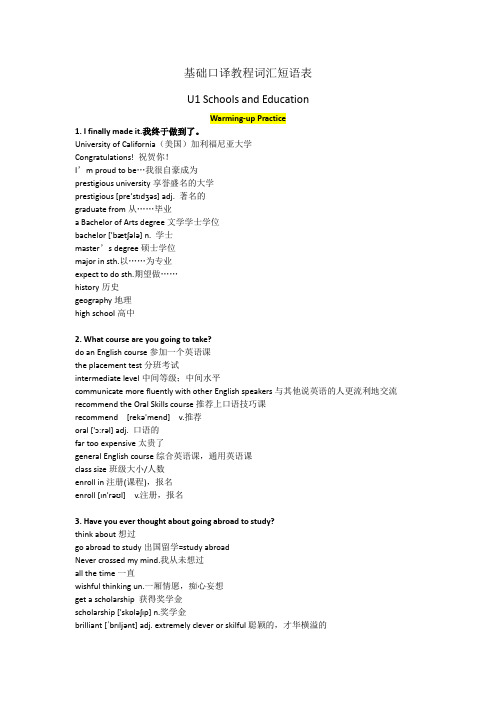
基础口译教程词汇短语表U1 Schools and EducationWarming-up Practice1. I finally made it.我终于做到了。
University of California(美国)加利福尼亚大学Congratulations! 祝贺你!I’m proud to be…我很自豪成为prestigious university享誉盛名的大学prestigious [pre'stɪdʒəs] adj. 著名的graduate from从……毕业a Bachelor of Arts degree文学学士学位bachelor ['bætʃələ] n. 学士master’s degree硕士学位major in sth.以……为专业expect to do sth.期望做……history历史geography地理high school高中2. What course are you going to take?do an English course参加一个英语课the placement test分班考试intermediate level中间等级;中间水平communicate more fluently with other English speakers与其他说英语的人更流利地交流recommend the Oral Skills course推荐上口语技巧课recommend [rekə'mend] v.推荐oral ['ɔːrəl] adj. 口语的far too expensive太贵了general English course综合英语课,通用英语课class size班级大小/人数enroll in注册(课程),报名enroll [ɪn'rəʊl] v.注册,报名3. Have you ever thought about going abroad to study?think about想过go abroad to study出国留学=study abroadNever crossed my mind.我从未想过all the time一直wishful thinking un.一厢情愿,痴心妄想get a scholarship 获得奖学金scholarship ['skɒləʃɪp] n.奖学金brilliant [ˈbrɪljənt] adj. extremely clever or skilful聪颖的,才华横溢的Don’t give up on your dream so easily. 不要轻易放弃你的梦想。
英语口译基础教程-Unit-1-Introduction
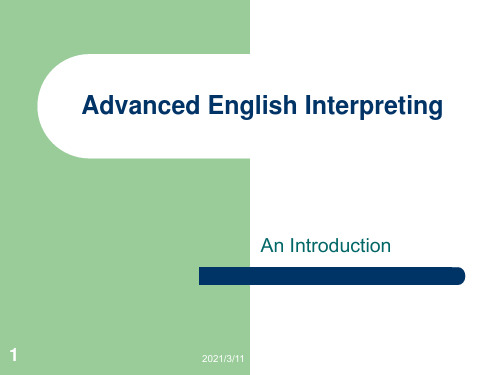
KI=KL+EK+S (P+AP) 译员应该掌握的知识 =双语知识+百科知识 +技能(职业 口译技能 +艺术表达技能 )
– KI=Knowledge Required for an Interpreter – KL=Knowledge for language – EK=Encyclopedic Knowledge – S (P+AP)=Professional Interpreting Skills and
By ways: one-way interpreting 单向口译 two-way interpreting 双向口译
9
2021/3/11
Types of interpreting
By contents: guide interpreting 导游口译 ceremony interpreting 礼仪口译 information interpreting 宣传口译 conference interpreting 会议口译 negotiation interpreting 谈判口译
美 经 中美合企 2年 I 说 dif@bus. man. 中← →美// we 更 直 率 比 中←不同文传// I x 我 bus. ++ 毕 有 + & - @both // 近年 美企exe. 强: hu 中管//
13
2021/3/11
Example 2: How do you interpret?
今晚,我们很高兴在北京大学再次接待我们的老朋友格林博士和夫人。 /我代表学校的全体师生员工向格林博士和夫人及其他新西兰贵宾表示热 烈的欢迎。//
我相信格林博士这次对我校的访问,必将为进一步加强两校的友好合 作关系作出重要的贡献。//
口译技能教程Unit1
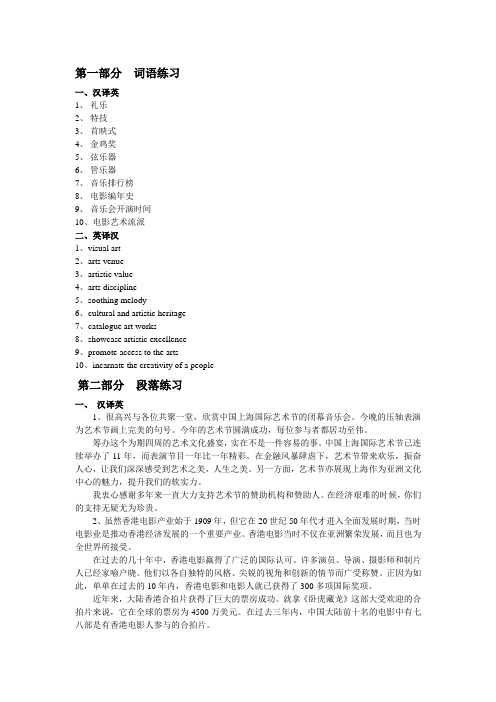
第一部分词语练习一、汉译英1、礼乐2、特技3、首映式4、金鸡奖5、弦乐器6、管乐器7、音乐排行榜8、电影编年史9、音乐会开演时间10、电影艺术流派二、英译汉1、visual art2、arts venue3、artistic value4、arts discipline5、soothing melody6、cultural and artistic heritage7、catalogue art works8、showcase artistic excellence9、promote access to the arts10、incarnate the creativity of a people第二部分段落练习一、汉译英1、很高兴与各位共聚一堂,欣赏中国上海国际艺术节的闭幕音乐会。
今晚的压轴表演为艺术节画上完美的句号。
今年的艺术节圆满成功,每位参与者都居功至伟。
筹办这个为期四周的艺术文化盛宴,实在不是一件容易的事。
中国上海国际艺术节已连续举办了11年,而表演节目一年比一年精彩。
在金融风暴肆虐下,艺术节带来欢乐,振奋人心,让我们深深感受到艺术之美,人生之美。
另一方面,艺术节亦展现上海作为亚洲文化中心的魅力,提升我们的软实力。
我衷心感谢多年来一直大力支持艺术节的赞助机构和赞助人。
在经济艰难的时候,你们的支持无疑尤为珍贵。
2、虽然香港电影产业始于1909年,但它在20世纪50年代才进入全面发展时期,当时电影业是推动香港经济发展的一个重要产业。
香港电影当时不仅在亚洲繁荣发展,而且也为全世界所接受。
在过去的几十年中,香港电影赢得了广泛的国际认可。
许多演员、导演、摄影师和制片人已经家喻户晓。
他们以各自独特的风格、尖锐的视角和创新的情节而广受称赞。
正因为如此,单单在过去的10年内,香港电影和电影人就已获得了300多项国际奖项。
近年来,大陆香港合拍片获得了巨大的票房成功。
就拿《卧虎藏龙》这部大受欢迎的合拍片来说,它在全球的票房为4500万美元。
英语口译基础教程Unit1Introdu

01
Introduction to Interpretation
Definition of Interpretation
It involves comprehending the exact meaning and intention of the source language and expressing it in the target language with accuracy and fluency
Executive Interpretation
The interpreter translates the spooked words of the source language after they have been delivered, either note taking or without notes
Standards for Interpretation
Accuracy
The interpreter must accurately translate the source language into the target language, ensuring that the meaning and intention are fully conveyed.
The interpreter needs to have a good memory to store and recall information during the interpretation process
Language conversion skills
Language comprehension
英语口译基础教程 1. interpreting course
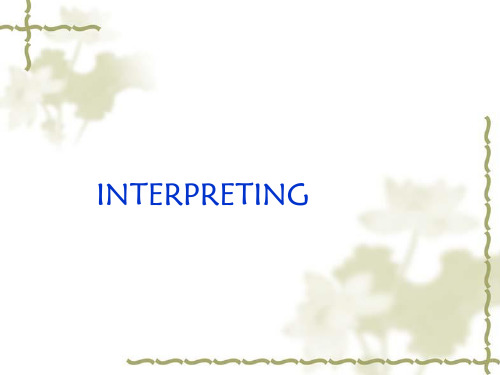
3) In terms of ways:
单向口译 ( one-way interpretation ) 双向口译 ( two-way interpretation )
A Brief history of conference interpreting as a modern profession
b. Dissimilarities The Other Basic Requirements for Interpreters
(1) Acute hearing (to grasp the meaning) (2)A good command of idioms, slang and proverbs, as well as register & appropriateness. (3)Phonetic competence (accent, intonation, stress and rhythms) & public speaking skills (4) Outstanding memory and note-taking ability (5) psychological competence: quick-witted, calm, resourceful (avoid panic and stage fright)
* Translating: i n p u t → c o m pr e h en s i on → (output)expression → checking
3) In terms of criteria a. Similarities: a faithful reproduction in natural TL. b. Differences:
口译unit one
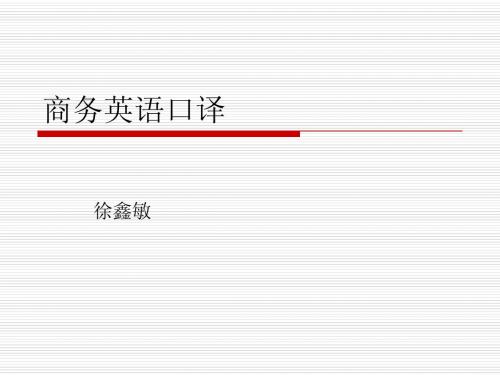
徐鑫敏
Part One Interpreting Theories
History and present situation of interpreting “译”、“寄”、“象”、“狄”、“通事”、“通译” “巴黎和会” “国际译协 口译的定义和分类 口译是一种通过听取和解析来源语所表达的信息,随即将其 转译为目标语的语言符号,进而达到传递信息之目的的言语 交际活动(梅德明,1996) 语言符号的转换不仅涉及到语言知识和体系,文化背景知识, 还涉及译员的语言表达能力,反应记忆能力和信息组合能力。 分类:即席翻译(consecutive interpreting) 同声传译 (simultaneous interpreting)
口译中的语体识别和对等转换
语体理论概说
语体定义: 指同一语言品种(标准语,方言, 社会方言等)的使用者在不同的场合中典型地使 用该语言品种的变体。 语体的特征取决于语境因素(语场,语旨,语式) 语体的双向预测功能
语体识别与对等转换在口译中的重要性
五种不同语体:庄严(frozen)、正式 (formal)、商议(consultative)、随意 (casual)、 随意(intimate) e.g. It was extremely gracious of you to have invited me to the reception, and I had bags of fun there. 前后语体不符
Sight interpretation
Paragraph 1
International Olympic Committee 国际奥林匹克委 员会(=COI) The National Games 全运会 Rehearsal 演练 Further 进一步;促进 Enhance 促进,增强,加强 Implement 生效,贯彻,执行 Attach great importance 十分重视 Extend full support 全力支持 Spare no efforts 不遗余力,尽力
- 1、下载文档前请自行甄别文档内容的完整性,平台不提供额外的编辑、内容补充、找答案等附加服务。
- 2、"仅部分预览"的文档,不可在线预览部分如存在完整性等问题,可反馈申请退款(可完整预览的文档不适用该条件!)。
- 3、如文档侵犯您的权益,请联系客服反馈,我们会尽快为您处理(人工客服工作时间:9:00-18:30)。
技能训练
面试
14-17周
18周
• 第一周: • 教学目的:使学生了解口译基本知识 • 教学内容:
I. 口译与笔译的不同:
工作环境不同:
口译具有很强的现场性和时限性。口译员必须面对公众 现场翻译,而笔译的工作环境则无限制。口译一般有很 强的时限性,口译员一般不能对已经翻译过的内容进行 大量的更正和补充,除非发现重大错漏。而在笔译中, 译者大多有充足的时间反复阅读原文,翻译完初稿后, 还可以反复修改润色直到译者满意为止。
In Chinese history, interpreters used to be called Tongues Man(舌人
V. 口译的主要形式
根据信息的传递形式,可分为
交替传译(连续传译)consecutive interpreting 同声传译 simultaneous interpreting
Textbooks for reference:
《口译基础》,苏伟,邓轶主编,上海外语教育出版社
《英语口译基础教程》,仲伟合主编,高等教育出版社
Course plan:
Skill-based, topic-oriented
Theory explanation Skill-training
Practice
各章节教学内容纲要 口译职业技能介绍 听辨 口译记忆 公众演讲 数字口译技巧 口译笔记
教学形式 知识介绍
时间安排 1周 2-5周 6-7周 8-9周 10-11周 12-13周
课堂讲解,技能 训练
课堂讲解,技能 训练 课堂讲解,专题 训练 课堂讲解,专题 训练 课堂讲解,技能 训练
综合练习
复习考试
Lecture 1 course description
Course objectives:
To familiarize you with the basic requirement of being an interpreter
To offer you basic training in the interpreting skills.
质量标准不尽相同
笔译讲究“信、达、雅”,口译则强调“准、顺、快”。“ 即准确,指准确理解原语信息并即时将其译成目的语。 “顺”即通顺,指译员在用目的语表达原语信息时要通顺 流畅,符合语言表达规范。“快”即译员反应要快,讲话 者的话音刚落,译员就要开始翻译。另外,口译质量的 判定还取决于参与交际的各方(如讲者、听者和雇主) 从各个角度所认定的交际效果。
汉语:词汇量、措辞能力、组句能力、修辞能力、 文学修养、古汉语知识
b 宽广的知识面:要了解百科基本知识,具备社会科学 人文科学和自然科学领域内的一般知识;关注国内外的 时政新闻和热点话题:科技进步、种族冲突、经济全球 化等。Know everything of something, and something of everything
II. Why to Be a Professional Interpreter?
4 Goods: Good places to visit Good food to eat Good money to make Good people to meet
III. 口译能力的构成:
A 智力因素
a 双语支柱 外语:听力是基础 1200个tape hours 词汇量、语法知识、阅读理解能力
工作方法不同
口译员通常独自工作,口译时一般无法求助于他人,也
没时间查阅词典或其他材料。而笔译员则可以随时查阅
各种参考书,反复斟酌,也可请教相关领域的专家。
反馈形式不同
口译是现场的翻译活动。译员面对讲话人和听众,可以 随时从他们的面部表情、情绪、手势和其他身势语中接 收到反馈信息,译员可根据现场的情况和听众的反馈及 时调整自己的音量、语速、用词等。而笔译员在翻译过 程中一般没有机会与作者和读者面对面进行交流,也无 法根据他们的反馈进行调整和修改。
c 跨文化意识:口译是跨语言、跨文化的交际活动,其 最终目的是要让听众和讲话人达到思想文化的交流。
B 非智力因素
心理ory of Conference Interpreting
During the 1919 Paris Peace Conference, CI debuted officially.
IBM first patented SI as a technique in 1926. In 1947, SI for English, French, Russian and German used full scale at the Nuremberg trial. SI has been with UN since 1947. Interpreting as a profession: the foundation of International Association of Conference Interpreters (AIIC) in 1953. Chinese was accepted as a working language in late 1970s.
根据口译的场合和内容,可分口译为
会议口译 conference interpreting 商务口译 business interpreting
法庭口译 court interpreting
媒体口译 media interpreting 社区口译 community interpreting
电话口译 telephone interpreting
To introduce to you the most frequently touched topics in real interpreting work and familiarize you with the basic vocabulary in those areas. To practise in and out of class.
Course requirements:
Attendance (punctuality) Class participation In-time handling of assignment
Evaluation:
Attendance Assignment
In-class performance
Final exam (in oral form)
